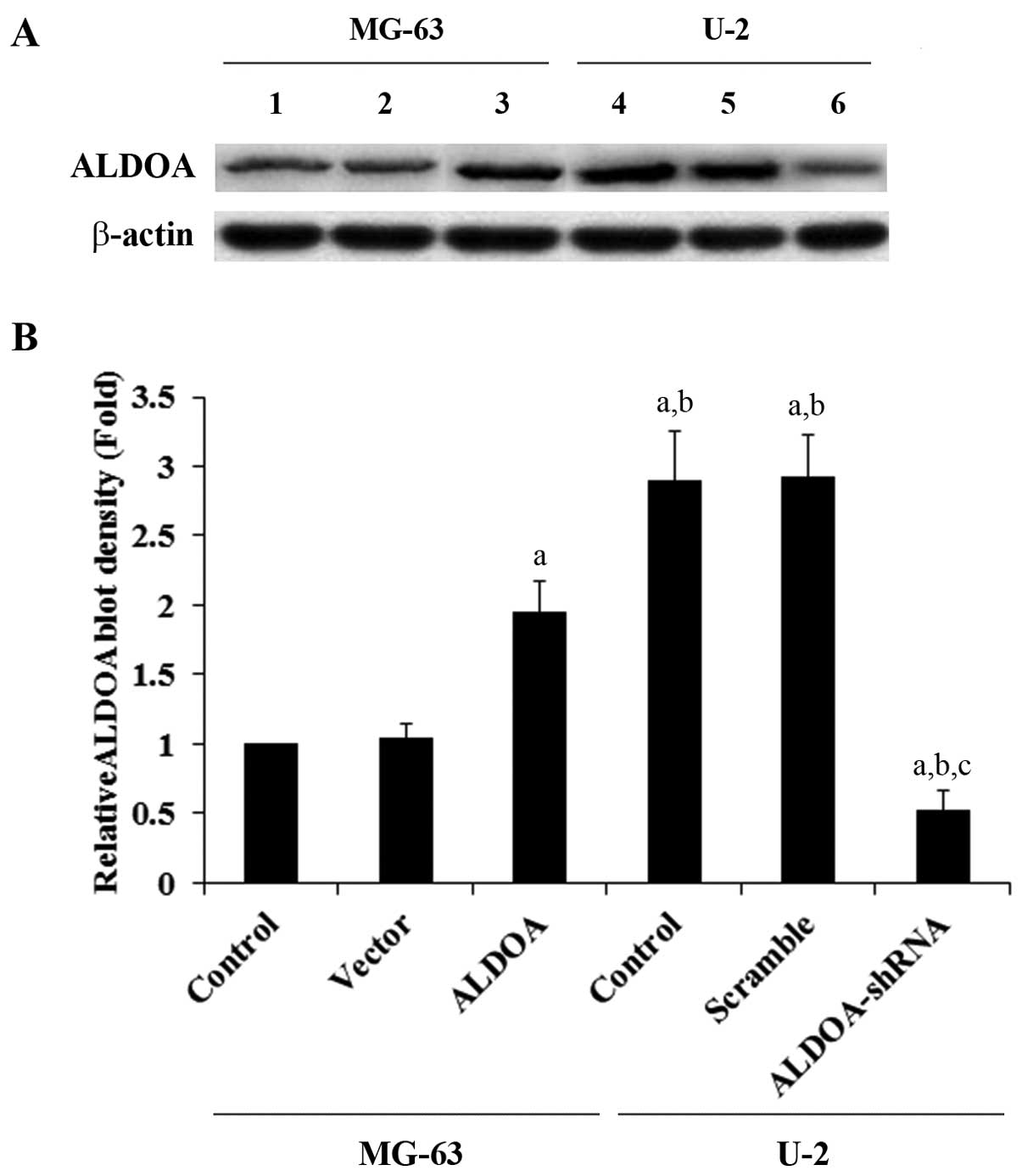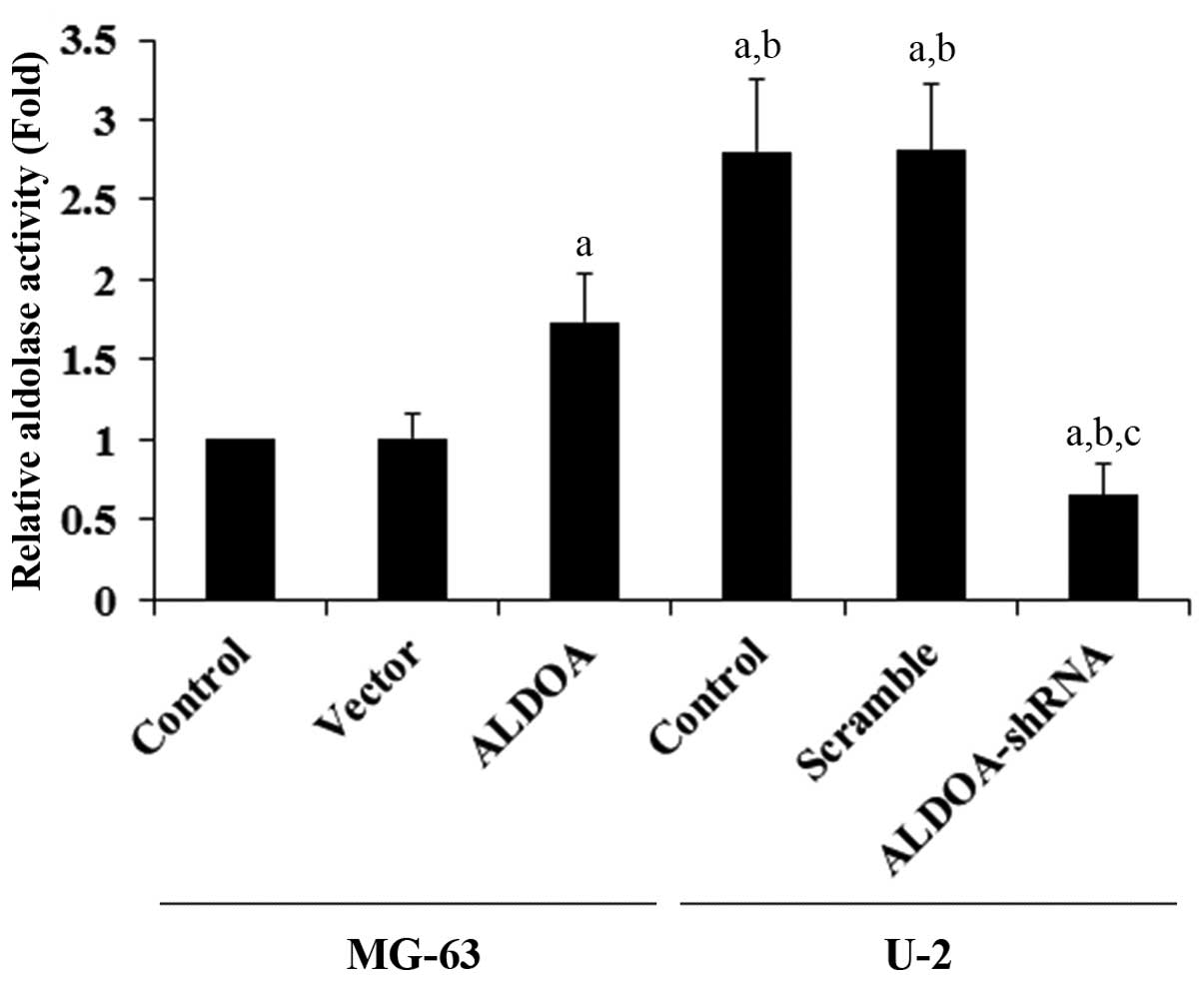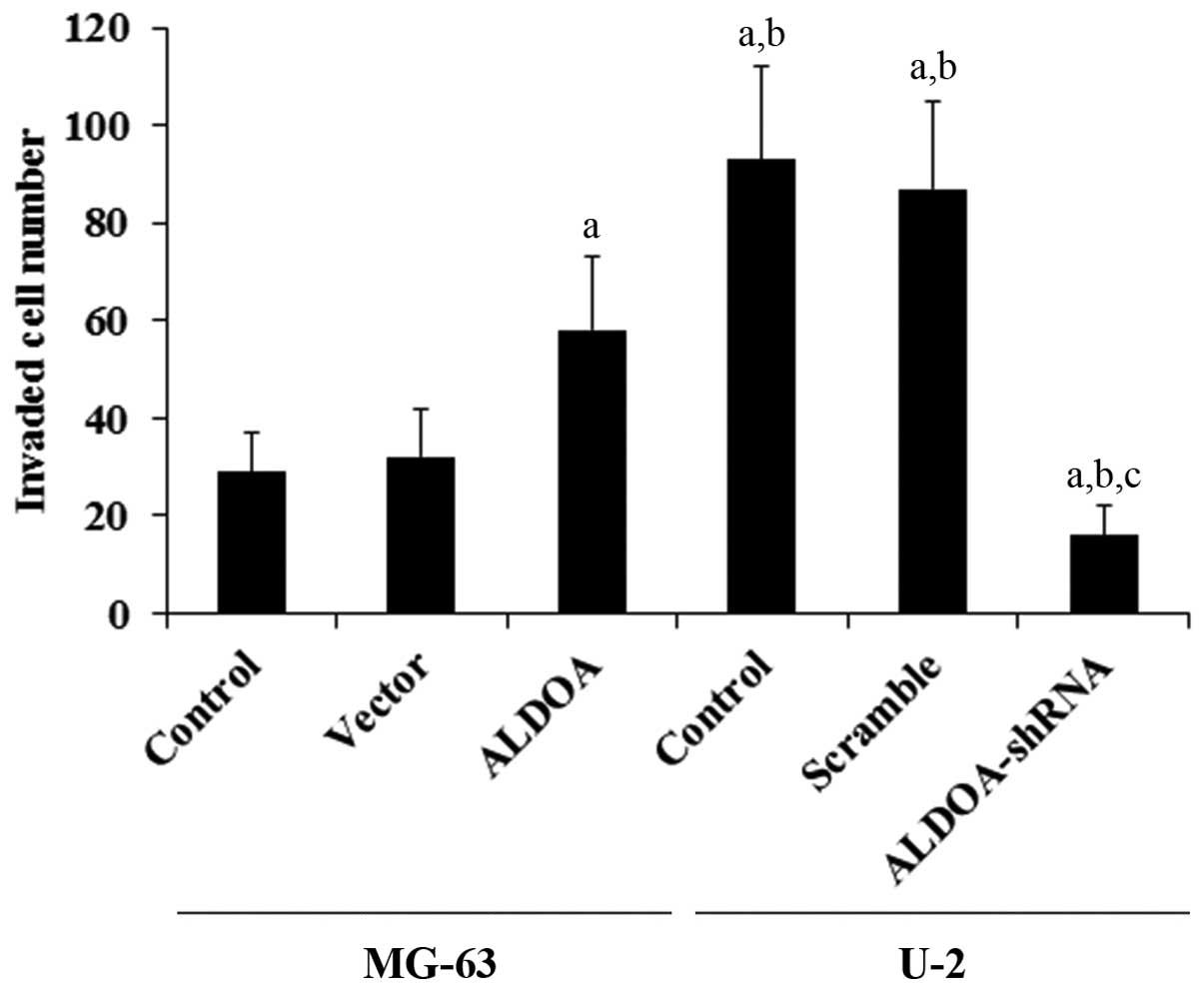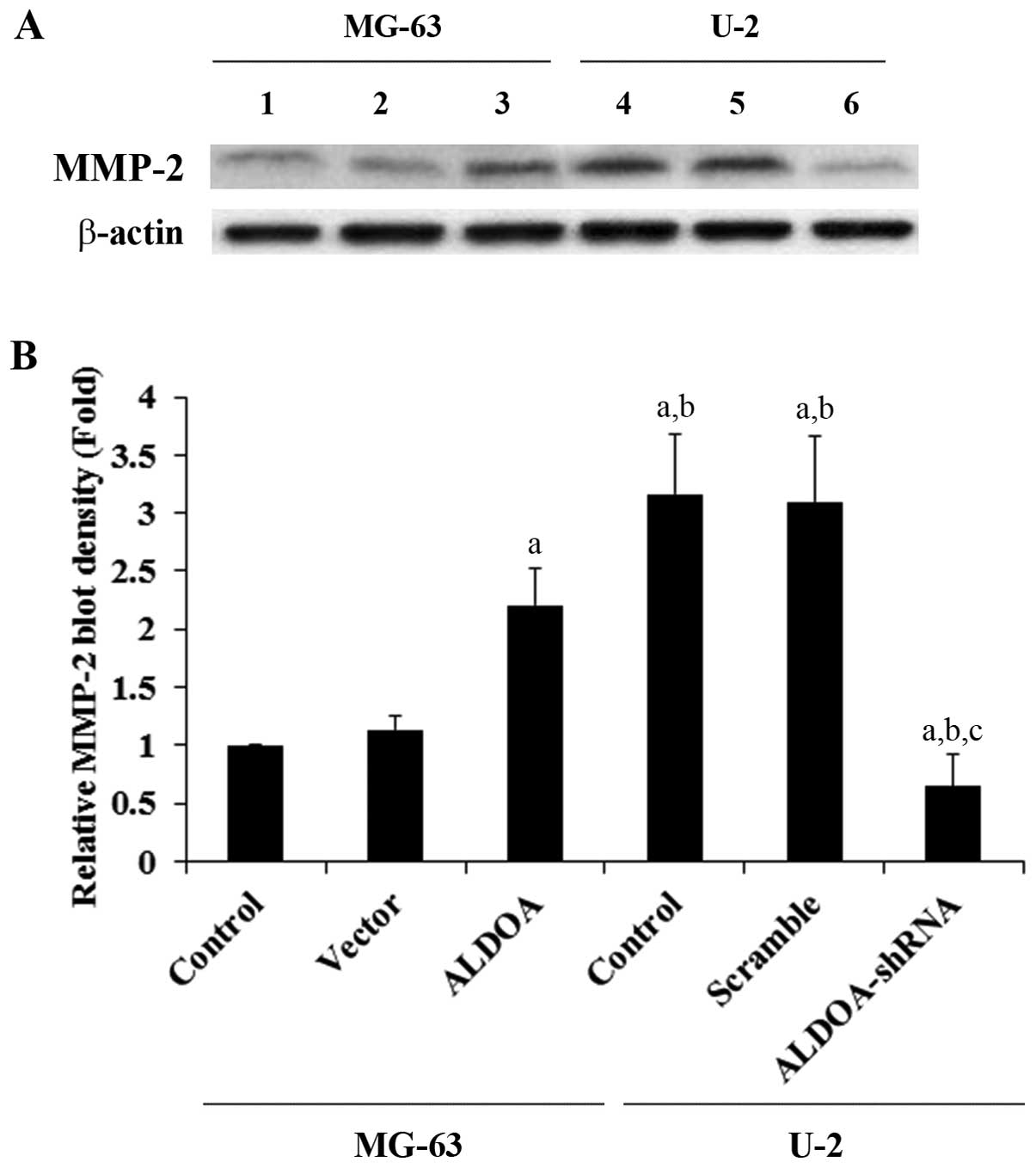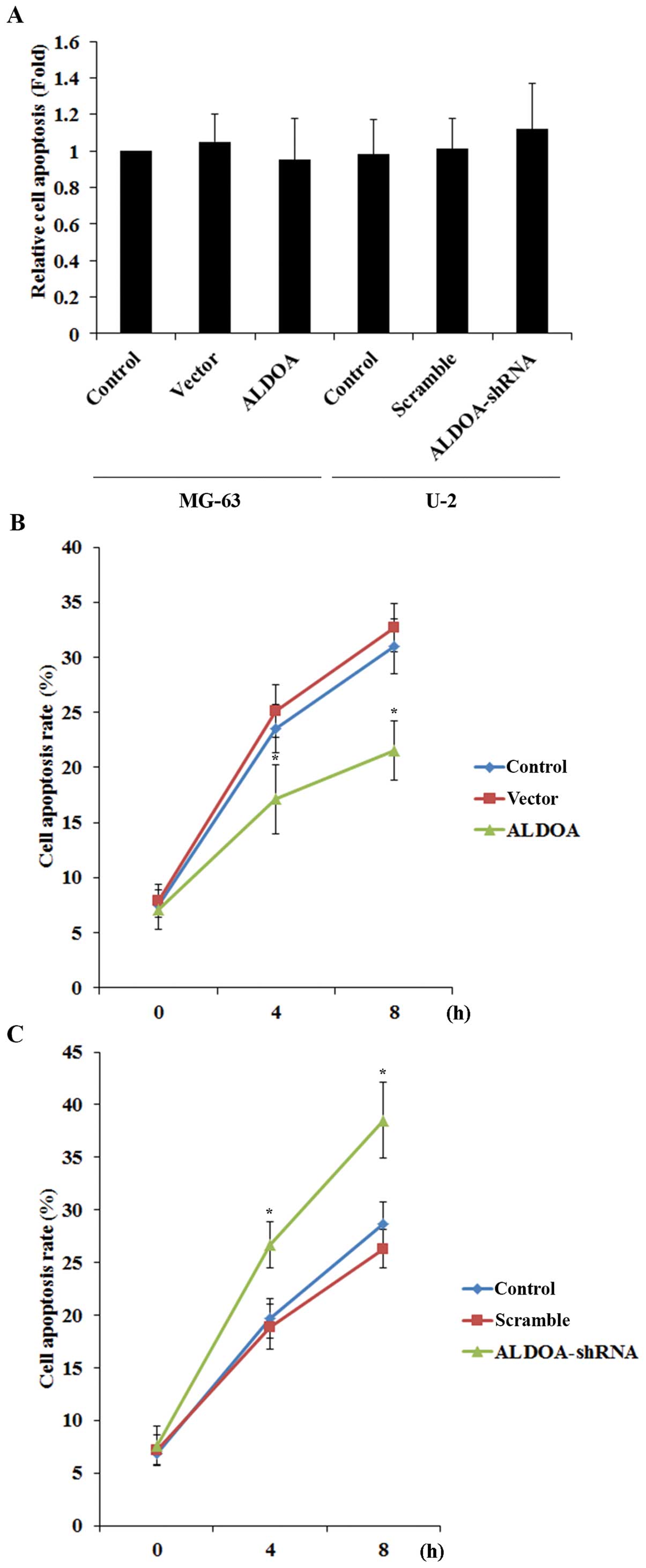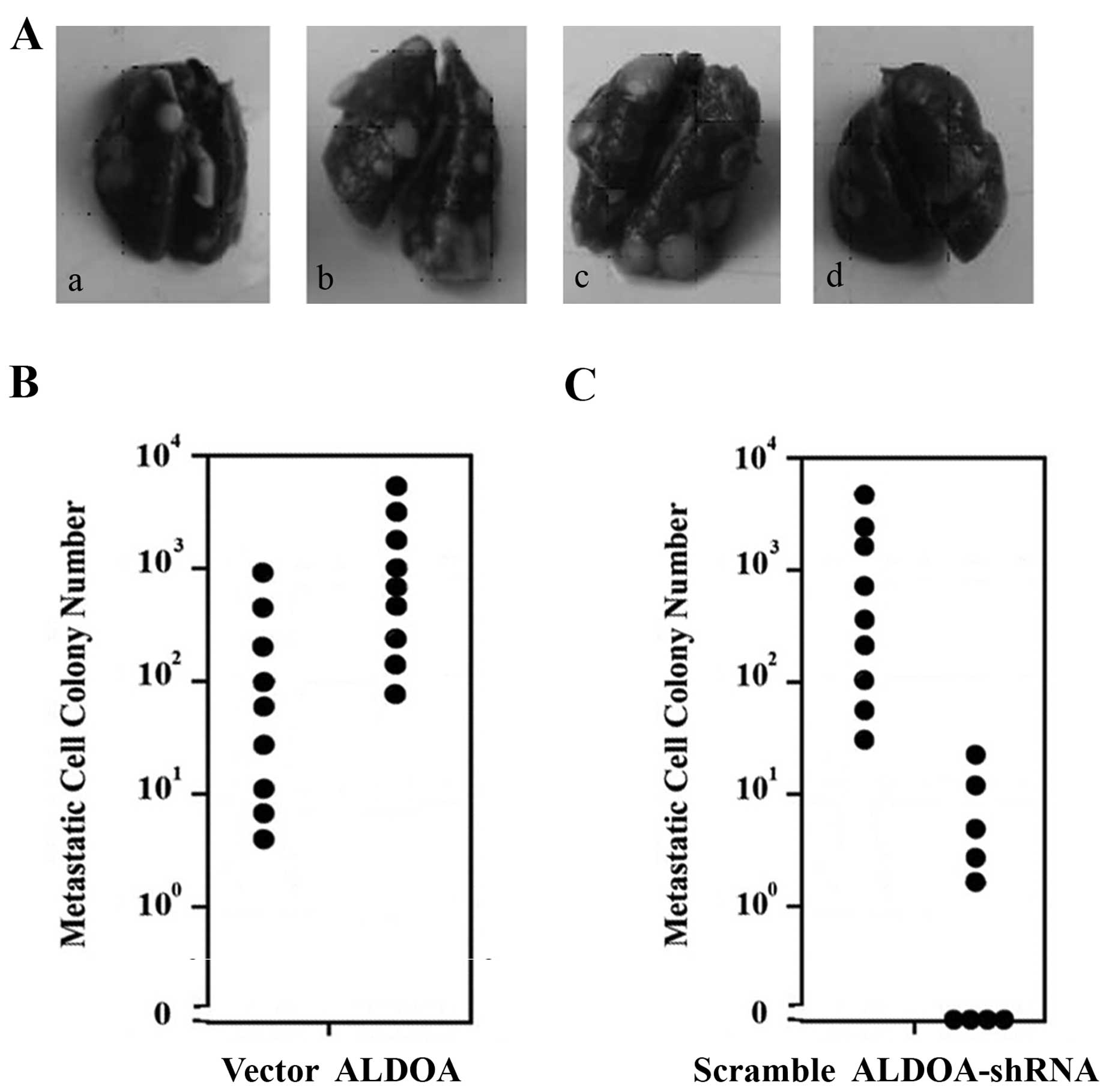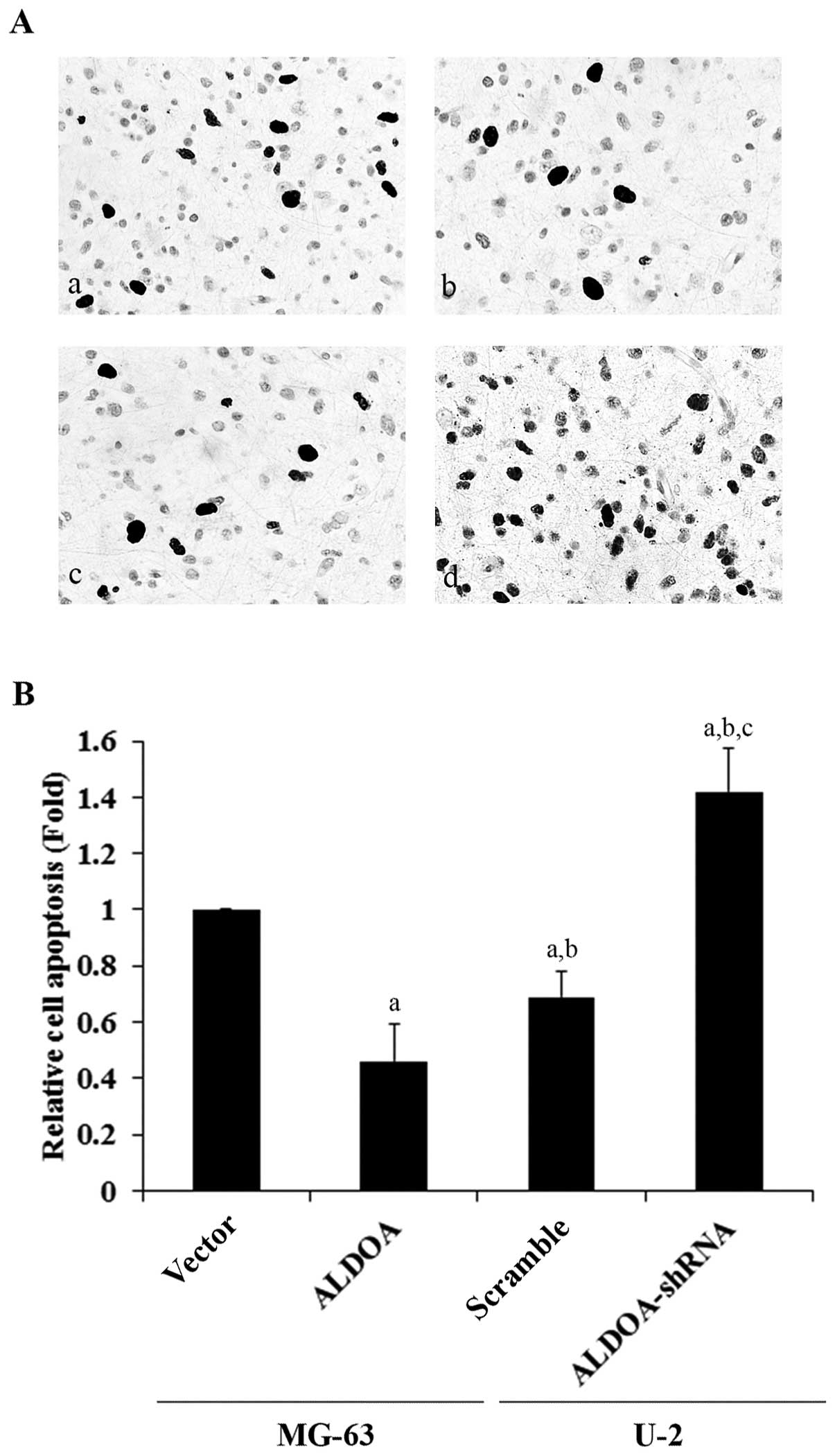Role of aldolase A in osteosarcoma progression and metastasis: In vitro and in vivo evidence
- Authors:
- Published online on: September 10, 2014 https://doi.org/10.3892/or.2014.3473
- Pages: 2031-2037
Abstract
Introduction
Osteosarcoma (OS) is the most common primary bone malignancy and the eighth most common type of cancer among children, comprising 2.4% of all malignancies in pediatric patients and ~35% of all bone cancers (1). The overall incidence is five cases per million individuals per year (1). OS is a devastating disease, characterized by high local aggressiveness and a tendency to metastasize to the lungs and distant bones. Pulmonary metastasis occurs in ~40–50% of OS patients and remains a major cause of fatal outcome (2–4). The cure rate of OS is ~65% for patients with localized diseases. When presenting with metastases at the time of diagnosis, the survival rate is 25% (4,6). Despite modern multidisciplinary treatments including chemotherapy and surgery, the 5-year survival rate of osteosarcoma patients remains 60–70% (1). Hence, there is an urgent need to develop novel approaches to treat osteosarcoma patients, particularly, to identify and confirm potential therapeutic targets involved in OS development and progression.
A new approach to therapeutic strategy is emerging, based on the peculiar metabolism of the cancer cell. Specifically, glycolysis has long been considered the main source of energy for the cancer cell (7). Fructose-bisphosphate aldolase (EC 4.1.2.13) is involved in glycolysis by converting fructose 1,6-diphosphate into dihydroxyacetone phosphate and glyceraldehyde-3-phosphate (8). The three aldolase isozymes (A, B and C) have a tetramer structure with identical molecular weights of ~160 kDa. It is well known that cancer cells with a high glycolytic rate often exhibit an aberrant expression of all glycolytic enzymes (8). It has been found that the control of glycolysis in rapidly growing tumor cells occurs at least partly at the level of the so-called consuming block (from aldolase to lactate dehydrogenase) (9). Accumulation of fructose-1,6-bisphosphate resulting from inhibition of aldolase-catalyzed cleavage should stop glycolysis and, therefore, cancer development and progression (8).
A recent study revealed that the expression of aldolase A (ALDOA) was significantly higher in OS patients with shorter survival time, suggesting that ALDOA is a negative survival marker of OS and may be implicated in OS development and progression (10). In the present study, for the first time we assessed the functional role of ALDOA in OS cell invasion and survival in vitro and in vivo, using human OS cell lines and an orthotopic xenograft OS nude mouse model.
Materials and methods
Cells lines, plasmids, reagents and mice
MG-63 and U-2 human OS cell lines were purchased from the American Type Culture Collection (ATCC; Rockville, MD, USA). Human ALDOA cDNA was subcloned into the pcDNA 3.1 expression vector (11). ALDOA (sc-29664-V) shRNA lentiviral particles, control shRNA lentiviral particles-A (sc-108080), and anti-ALDOA (N-15) (sc-12059) and anti-matrix metalloproteinase-2 (MMP-2) antibodies (sc-53630) were purchased from Santa Cruz Biotechnology (Santa Cruz, CA, USA). The aldolase activity in cell extracts was analyzed with an aldolase test kit (CALD 015) purchased from Caldon Biotech (Vista, CA, USA). DeadEnd™ Fluorometric TUNEL system was purchased from Promega (Madison, WI, USA). ApopTag® Peroxidase In Situ Apoptosis Detection kit (S7100) was purchased from Millipore (Billerica, MA, USA). SuperFect™ transfection reagent was purchased from Qiagen (Valencia, CA, USA). Puromycin, G418, cisplatin and all chemicals of reagent grade were purchased from Sigma (St. Louis, MO, USA). Five-week-old BALB/C female nude mice were purchased from Central South University (Changsha, China) and were housed at the Xiangya Hospital BioResources Centre. All animal care, breeding and testing procedures were approved by the Laboratory Animal Users Committee of Xiangya Hospital, Central South University, Changsha, China.
Transfection and lentiviral transduction
The human ALDOA expression constructs were transfected into MG-63 cells using SuperFect™ transfection reagent, and pools of stable transductants were generated via selection with G418 (800 μg/ml) according to the manufacturer’s protocol (Qiagen). Lentiviral transduction was performed in U-2 cells, and pools of stable transductants were generated via selection with puromycin (5 μg/ml) according to the manufacturer’s protocol (Santa Cruz Biotechnology).
In vitro cell invasion assay
Transwell® cell invasion assays (Corning Life Sciences, Tewksbury, MA, USA) were performed as previously described (12). Briefly, Transwell® cell-culture chambers with an 8-μm pore size (BD Biosciences, Bedford, MA, USA) for 24-well plates were coated with 50 μl Matrigel (BD Biosciences). OS cells were seeded into the upper chamber at 5×105 cells/well in RPMI-1640 serum-free medium. Complete medium (600 ml) was added to the lower chamber. Cells were allowed to invade for 24 h followed by fixation and staining with crystal violet. Invaded cells which adhered to the bottom of the filter were counted in 10 random fields per chamber under a microscope. Each experiment was repeated three times in triplicates.
Western blot analysis
Immunoblotting was performed with the respective antibodies. Briefly, cells were dissolved in 250 μl of 2X SDS loading buffer (62.5 mm Tris-HCl, pH 6.8, 2% SDS, 25% glycerol, 0.01% bromophenol blue, 5% 2-mercaptoethanol), and incubated at 95°C for 10 min. Equal amounts of proteins for each sample were separated by 10% SDS-polyacrylamide gel and blotted onto a polyvinylidene difluoride microporous membrane (Millipore). Membranes were incubated for 1 h with a 1/1,000 dilution of primary antibody, and then washed and revealed using secondary antibodies with horseradish peroxidase conjugate (1/5,000, 1 h). Peroxidase was revealed with a GE Healthcare ECL kit. Proteins were quantified before being loaded onto the gel.
Measurement of apoptosis by terminal deoxynucleotidyl transferase mediated nick-end labeling (TUNEL) assay
The TUNEL assay was performed using the DeadEnd™ Fluorometric TUNEL system according to the manufacturer’s protocol (Promega). Cells were treated with cisplatin (10 nM) for 8 h. Apoptotic cells exhibit a strong nuclear green fluorescence that can be detected using a standard fluorescein filter. All cells stained with DAPI exhibit a strong blue nuclear fluorescence. The slides were observed using fluorescence microscopy and the relative apoptotic cells were determined by counting TUNEL-positive cells in five random fields (magnification, ×100) for each sample.
Establishment of an orthotopic xenograft OS nude mouse model
OS cells were mixed with 50% Matrigel to a concentration of 2×106 cells/ml. Mice were anesthetized by intraperitoneal injection of ketamine (100 mg/kg body weight) and xylazine (10 mg/kg body weight). A volume of 10 μl of cells/Matrigel solution was injected into the left tibia of individual nude mice using a 27-gauge needle (12). The needle was inserted into the tibial tuberosity and advanced using a drilling motion to avoid fracture of the bone. The mice were monitored three times weekly for tumor growth and signs of distress. Tumors were measured in the anteroposterior and lateral planes using digital callipers. Leg volume and tumor volume were calculated using the formula: 4/3π (1/4(AP + L)2 where AP is the anteroposterior measurement and L is the lateral measurement (13). The volume of the contralateral limb was subtracted from the tumor-bearing limb to calculate the actual tumor volume. Mice were weighed using digital scales. Tumor growth was evaluated until death or sacrifice when tumor dimensions exceeded 5% of the body weight or mice showed dyspnea, abnormal posture, >20% body weight loss, difficulty with ambulation or any other clinical sign of metastatic disease causing significant pain or distress, according to the institutional guidelines.
Clonogenic lung metastasis assay
Clonogenic lung metastasis assays were performed as previously described (14,15). Briefly, lungs from each individual animal were minced into 1-mm pieces, and digested with 5 ml enzyme cocktail containing 1 mg/ml collagenase IV and 6 units/ml elastase in PBS for 1 h at 4°C with rotation. Cell suspensions were filtered through 70-Amnylon cell strainers and washed two times with Hank’s buffered saline, and then resuspended in complete medium. The cells were then cultured in 10-cm tissue culture dishes and treated with 1.25 mg/ml of G418 or 5 μg/ml of puromycin to allow only the growth of MG-63 and U-2 cells, respectively. When colonies of the growing cells became visible (8–14 days), the plates were washed with phosphate-buffered saline, fixed with methanol and stained with crystal violet. The colonies were counted independently by two investigators, blinded to the group to which each nude mouse belonged, and the total colony number/lungs was calculated for each animal.
Immunohistochemistry
Apoptosis in the primary OS tumor tissue was evaluated using the ApopTag® Peroxidase In Situ Apoptosis Detection kit according to the manufacturer’s protocol (Millipore). Light hematoxylin was used for counterstaining. After staining, apoptosis was determined from 500 randomly selected cells as the proportion of cells with apoptotic nuclei.
Statistical analysis
Statistical analyses were performed with SPSS for Windows 10.0. Data values are expressed as means ± SD. Comparison of the means between two independent groups was performed with the Student’s t-test. Comparison of the means among multiple groups was performed with one-way ANOVA followed by post hoc pairwise comparisons using Tukey’s tests. Two-tailed P<0.05 was considered to indicate a statistically significant result in the present study.
Results
As shown in Fig. 1, while ALDOA was amply expressed in U-2 OS cells, it was expressed at a relatively low constitutive level in the MG-63 cells. The two cell lines allowed the specific ALDOA overexpression or knockdown studies to be performed in the context of the study goals. Thus, we stably transfected MG-63 cells with an ALDOA expression vector to overexpress ALDOA, and we stably transduced U-2 cells with ALDOA-shRNA to knock down ALDOA. Compared with the controls, ALDOA was overexpressed ~2-fold in the MG-63 cells, and the endogenous ALDOA level was knocked down ~80% in the U-2 cells (Fig. 1). Aldolase activity assays using the cell extracts showed that U-2 cells had higher constitutive aldolase activity when compared with that in the MG-63 cells (Fig. 2). ALDOA overexpression significantly increased the aldolase activity in the MG-63 cells, when compared with the controls. On the other hand, ALDOA knockdown markedly decreased the aldolase activity in the U-2 cells (Fig. 2).
To examine the effect of ALDOA on OS cell invasion, we performed in vitro cell invasion assays and examined the MMP expression level in OS cells. Overexpression of ALDOA in MG-63 cells increased cell invasion by ~1-fold when compared with that of the controls, while knockdown of ALDOA in U-2 cells decreased cell invasion by ~80% (Fig. 3). A similar trend in data was observed for the expression of MMP-2 (Fig. 4).
To explore the effect of ALDOA on OS survival, we examined cell apoptosis in OS cells treated with 10 nM of cisplatin, an apoptosis-inducing chemotherapeutic agent commonly used to treat OS. Overexpression or knockdown of ALDOA did not significantly alter the rate of cell apoptosis in both the MG-63 and U-2 cells under normal culture conditions (Fig. 5A). However, in the MG-63 cells treated with cisplatin, overexpression of ALDOA significantly decreased the rate of cell apoptosis when compared with the controls (Fig. 5B). In the U-2 cells, knockdown of ALDOA significantly increased cell apoptosis in the presence of cisplatin (Fig. 5C).
To assess the role of ALDOA in OS progression and metastasis in vivo, we employed an orthotopic xenograft OS nude mouse model. MG-63 cells stably transfected with the empty pcDNA3 expression vector or ALDOA, and U-2 cells stably transduced with scramble control shRNA or ALDOA-shRNA were used for intra-tibial injection, respectively. Twenty-eight days after the injection, 67% (6/9) of the mice in the vector control (vector) group, 100% (9/9) in the ALDOA overexpression group, 100% (9/9) in the scramble control (scramble) group, and 22% (2/9) in the ALDOA knockdown (ALDOA-shRNA) group exhibited obvious dyspnea and distress. All animals were sacrificed on day 28 post injection, and the lungs were collected. As shown in Fig. 6, mice injected with the MG-63 cells overexpressing ALDOA showed significantly larger primary tumors than those noted in the vector controls at day 21 post injection. In contrast, mice injected with the U-2 cells with ALDOA knockdown showed significantly smaller primary tumors than those noted in the scramble controls at day 14 post-injection. Compared with the vector control group, the ALDOA overexpression group showed obviously more metastatic nodules on the lung surface as well as more swollen and congested lungs (Fig. 7A). In comparison with the scramble control group, the ALDOA knockdown group showed apparently fewer metastatic nodules on the lung surface as well as less swollen and congested lungs (Fig. 7A). To quantitate the pulmonary metastasis, clonogenic lung metastasis assays were performed. As shown in Fig. 7B, the number of lung metastases in the ALDOA overexpression group were significantly more than these numbers in the vector control group. In contrast, the ALDOA knockdown group showed markedly fewer metastases than the scramble control group (Fig. 7C).
To explore the effect of ALDOA on OS cell survival in vivo, we examined cell apoptosis in the primary tumors in the orthotopic xenograft OS mouse nude model. As shown in Fig. 8, mice injected with the MG-63 cells overexpressing ALDOA showed significantly lower OS cell apoptosis rates in the primary tumors than those injected with the vector control cells. On the other hand, mice injected with the U-2 cells with knockdown of ALDOA showed significantly higher OS cell apoptosis rates in the primary tumors than those injected with the scramble control cells.
Discussion
Inhibiting cancer cell glycolysis is an emerging therapeutic strategy for cancer (8). A recent study suggested that ALDOA, an important enzyme involved in glycolysis (8), is a negative survival marker of OS and may be implicated in OS development and progression. In the present study, our in vitro data revealed that ALDOA promoted OS cell invasion and survival, and our in vivo data demonstrated an important role of ALDOA in promoting OS tumor growth and metastasis.
MG-63 and U-2 cells were used as OS cell models in the present study. MG-63 cells expressed a relatively low constitutive level of ALDOA when compared with the U-2 cells. Thus, overexpression and knockdown of ALDOA were respectively performed in the two cell lines to approach the study objectives from different angles. Changes in the aldolase activity were in line with those in the ALDOA expression levels, indicating that overexpression and knockdown of ALDOA indeed led to an alteration in the enzymatic activity in the OS cells.
OS is characterized by high local aggressiveness and a tendency to metastasize to the lungs, which remains a major cause of fatal outcome (4). Thus, we performed in vitro cell invasion assays to explore the effect of ALDOA on OS cell invasiveness. Overexpression of ALDOA increased cell invasion in MG-63 cells, which had a relatively low constitutive level of ALDOA expression and invasive activity, while knockdown of ALDOA nearly abolished cell invasion in the U-2 cells, which had a relatively high constitutive level of ALDOA expression and invasive activity. The findings suggest that ALDOA is critical for OS cell invasion. Among the different MMPs, MMP-2 showed expression level changes in line with the cell invasive activity changes in the OS cells, suggesting that ALDOA promotes OS cell invasion through upregulation of MMP-2 expression. Further studies are needed to ascertain how ALDOA regulates MMP-2 expression.
Cell survival against apoptotic stress is critical for cancer progression and metastasis (16). In the present study, we used a relatively small concentration of cisplatin (10 nM) to induce apoptotic stress without killing most of the cells. In the presence of cisplatin, overexpression of ALDOA in the MG-63 cells significantly decreased cell apoptosis, while knockdown of ALDOA in the U-2 cells markedly increased cell apoptosis compared with the controls. The findings indicate that ALDOA is important for OS cell survival against apoptotic stress, which not only suggests a functional role for ALDOA in OS progression and metastasis, but also implicates ALDOA in the development of OS chemoresistance. Cisplatin elicits DNA repair mechanisms by crosslinking DNA, which in turn activates apoptosis when repair proves impossible (17). It is still unclear whether ALDOA impacts OS cell survival against other types of chemotherapeutic agents. Further studies with more types of chemotherapeutic agents and OS cell lines would elucidate this issue.
Based on the in vitro evidence that ALDOA plays an important role in OS cell invasion and survival, we used an orthotopic xenograft OS nude mouse model to further explore the functional role of ALDOA in OS progression and metastasis in vivo. As pulmonary metastasis is a major cause of fatal outcome in OS, we focused on lung metastasis in the mouse model, and the intra-tibial injection model in nude mice has proved to be a biologically relevant and adequate animal model for the induction of reproducible pulmonary metastasis (15). A combination of clinical signs, organ examinations, tumor volume analyses, and quantitative lung metastasis assays in the animal model demonstrated that ALDOA promotes OS primary tumor growth and pulmonary metastasis in vivo. Additionally, overexpression and knockdown of ALDOA decreased and increased cell apoptosis in the primary OS tumors, respectively, confirming the in vitro promoting effects of ALDOA on OS cell survival against the apoptotic stress induced by low-dose cisplatin.
The aldolase (ALDO) isozymes (A, B and C) are encoded by three different genes, differentially expressed during development. ALDOA is mainly produced by the developing embryo and in adult muscle; ALDOB is produced by liver, kidney and intestine; and ALDOC is mainly produced by brain and other nervous tissue. ALDOA and ALDOB have been associated with poor prognosis of OS and hepatocarcinomas, respectively (10,18). Future studies of whether and how ALDOB and ALDOC are involved in OS development and progression are warranted.
In conclusion, the present study provides the first in vitro and in vivo evidence supporting a critical functional role of ALDOA in OS progression and metastasis, suggesting that ALDOA could serve as a novel therapeutic target in OS. Additionally, our results also suggest that ALDOA is involved in the development of OS chemoresistance.
References
|
Ottaviani G and Jaffe N: The epidemiology of osteosarcoma. Cancer Treat Res. 152:3–13. 2010. View Article : Google Scholar | |
|
Bacci G, Briccoli A, Rocca M, et al: Neoadjuvant chemotherapy for OS of the extremities with metastases at presentation: recent experience at the Rizzoli Institute in 57 patients treated with cisplatin, doxorubicin, and a high dose of methotrexate and ifosfamide. Ann Oncol. 14:1126–1134. 2003. View Article : Google Scholar | |
|
Kager L, Zoubek A, Potschger U, et al: Primary metastatic OS: presentation and outcome of patients treated on neoadjuvant Cooperative OS Study Group protocols. J Clin Oncol. 21:2011–2018. 2003. View Article : Google Scholar : PubMed/NCBI | |
|
Ta HT, Dass CR, Choong PF and Dunstan DE: Osteosarcoma treatment: state of the art. Cancer Metastasis Rev. 28:247–263. 2009. View Article : Google Scholar : PubMed/NCBI | |
|
Gorlick R, Anderson P and Andrulis I: Biology of childhood osteogenic sarcoma and potential targets for therapeutic development: meeting summary. Clin Cancer Res. 9:5442–5453. 2003.PubMed/NCBI | |
|
Wittig JC, Bickels J and Priebat D: Osteosarcoma: a multidisciplinary approach to diagnosis and treatment. Am Fam Physician. 65:1123–1132. 2002.PubMed/NCBI | |
|
Gatenby RA and Gillies RJ: Why do cancers have high aerobic glycolysis? Nat Rev Cancer. 4:891–899. 2004. View Article : Google Scholar : PubMed/NCBI | |
|
Scatena R, Bottoni P, Pontoglio A, Mastrototaro L and Giardina B: Glycolytic enzyme inhibitors in cancer treatment. Expert Opin Investig Drugs. 17:1533–1545. 2008. View Article : Google Scholar : PubMed/NCBI | |
|
Marin-Hernandez A, Rodríguez-Enríquez S, Vital-González PA, et al: Determining and understanding the control of glycolysis in fast-growth tumor cells. Flux control by an over-expressed but strongly product-inhibited hexokinase. FEBS J. 273:1975–1988. 2006. View Article : Google Scholar : PubMed/NCBI | |
|
Chen X, Yang TT, Zhou Y, et al: Proteomic profiling of osteosarcoma cells identifies aldoa and sult1a3 as negative survival markers of human osteosarcoma. Mol Carcinog. Sep 4–2012.(Epub ahead of print). | |
|
Sakakibara M, Takahashi I, Takasaki Y, Mukai T and Hori K: Construction and expression of human aldolase A and B expression plasmids in Escherichia coli host. Biochim Biophys Acta. 1007:334–342. 1989. View Article : Google Scholar : PubMed/NCBI | |
|
Dass CR, Ek ET, Contreras KG and Choong PF: A novel orthotopic murine model provides insights into cellular and molecular characteristics contributing to human osteosarcoma. Clin Exp Metastasis. 23:367–380. 2006. View Article : Google Scholar | |
|
Ek ETH, Dass CR, Contreras KG and Choong PFM: Inhibition of orthotopic osteosarcoma growth and metastasis by multitargeted antitumour activities of pigment epithelium-derived factor. Clin Exp Metastasis. 24:93–106. 2007. View Article : Google Scholar : PubMed/NCBI | |
|
Pilones KA, Kawashima N, Yang AM, et al: Invariant natural killer T cells regulate breast cancer response to radiation and CTLA-4 blockade. Clin Cancer Res. 15:597–606. 2009. View Article : Google Scholar : PubMed/NCBI | |
|
Li Y, Liao Q, Li K, et al: Knockdown of endothelin A receptor expression inhibits osteosarcoma pulmonary metastasis in an orthotopic xenograft mouse model. Mol Med Rep. 5:1391–1395. 2012. | |
|
Hopkin K, Edwards P, Harris A, Klausner R, Peters G, Selby P and Stanley M: Cancer. Molecular Biology of the Cell. Alberts B, Johnson A and Lewis J: 4th edition. Garland Science; New York: pp. 1324–1325. 2002 | |
|
Rosenberg B, Vancamp L, Trosko JE and Mansour VH: Platinum compounds: a new class of potent antitumour agents. Nature. 222:385–386. 1969. View Article : Google Scholar : PubMed/NCBI | |
|
Peng SY, Lai PL, Pan HW, Hsiao LP and Hsu HC: Aberrant expression of the glycolytic enzymes aldolase B and type II hexokinase in hepatocellular carcinoma are predictive markers for advanced stage, early recurrence and poor prognosis. Oncol Rep. 19:1045–1053. 2008. |



